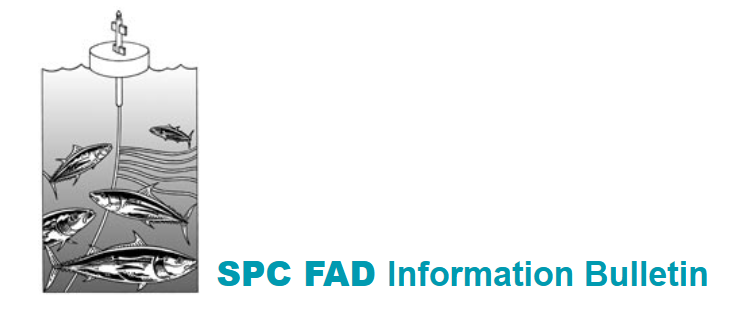
Group Coordinator
Production
Pacific Community, Fisheries Aquaculture and Marine Ecosystems Division, Information Section, SPC, BP D5, 98848 Noumea Cedex, New Caledonia.
Produced with financial assistance from France
Editorial
‘Why do tuna gather around FADs? How long do tuna stay near FADs? Why do some FADs seem to attract more tuna than others?’ These are some of the many questions which interest researchers working for the ECOTAP (Tuna Behaviour Study through Acoustics and Longline Fishing) programme in French Polynesia. Pascal Bach and six other scientists participating in the programme summarise (p. 3) the preliminary results obtained during experimental fishing carried out in the vicinity of FADs. Through concurrent use of ultrasonic telemetry to track tuna and acoustic surveys to observe the surrounding environment, these researchers have demonstrated the important effect which the biological environment has on horizontal and vertical tuna movements.
A large-scale study was carried out by Jean-Philippe Detolle and four other scientists in La Reunion Island in the Indian Ocean for the purpose of optimising FAD costs and lifespans. In addition to the technical options proposed following an analysis of all the critical points in the fabrication of mooring lines, the authors address FADs’ importance to the continuation and development of artisanal fishing activities on the island. The extract selected for this publication (p. 19) covers the social and economic aspects of FADs through a study of their effects on the number of working fishermen, catches and income. Oddly enough, few studies of this kind exist, although they are, in fact, essential when it comes to convincing governments and possible institutional donors of the merits of continuing FAD programmes.
Again in the same region, Michel de San, one of the designers of a type of FAD which uses a surface array of small trawl buoys, summarises experiences with FADs in the Western Indian Ocean on page 24. In that part of the world, the FADs deployed are simple to make and costs are kept down to the bare minimum. Fishing techniques there are very similar to those used in the Pacific. Readers from the Pacific area will be surprised to learn that FADs may first have been used in the Mediterranean and not in the Philippines as they had always thought.
After the Pacific and Indian Oceans, we could not neglect the Atlantic. The news comes from the island of Martinique, where Marc Taquet, Paul Gervain and Alain Lagin (p. 30) present a very original technique used for recovering lost FADs. This technique made it possible to analyse the mooring lines of the FADs recovered and identify the causes of failure. The results confirmed that most problems occur in the upper part of moorings, which is where most of the efforts for improvement should therefore be concentrated. What’s more, the success obtained in Martinique with ultra-light, very low-cost FADs (about onetenth the price of FADs used in the Pacific) should raise a lot of interest among those countries in our region whose FAD programmes have been put on hold for lack of resources.
Finally, Max Palladin, a consultant for SEPIA International, presents a security system for FADs developed in Sao Tome (p. 35). A brilliant idea which is simple to implement.
In Alain Fonteneau and Jean-Pierre Hallier’s article ‘La pêche aux thons sous objets flottants ’ (‘Fishing for tuna around floating objects’) published in the November 1992 issue of La Recherche and translated for the second issue of this bulletin, the authors conclude by noting: ‘The potential impact of artificial floating objects on tuna resources and the environment will (...) require careful appraisal, to make sure that the development of this fishing technique (which appears very attractive initially) does not have negative consequences on the ecological balances of the ocean.’
Five years later, it must be noted that development of this technique by the fishing industry has been much more rapid than assessment of its impact, particularly as concerns bigeye tuna stocks (see the article from Fishing News International on p. 37). According to the latest news, following expressions of concern by scientists, the fishing companies themselves have decided to implement a three-month moratorium on the use of this technique in some parts of the Atlantic Ocean. Close attention should be paid to developments in this area.
Scientific discoveries, new techniques, a social and economic approach, ideas, inventions, not to forget concerns ... FADs certainly aggregate lots of discussion!
Happy reading.
Aymeric Desurmont
Contents
- Experimental research and fish aggregating devices (FADs) in French Polynesia by P. Bach et al.
- The dynamics and effects of FADs in La Reunion Island by J.-P. Detolle et al.
- FAD – The Western Indian Ocean experience by M. de San et al.
- Recovering FADs lost at a depth of 2000 m by M. Taquet et al.
- Safety system developed for light FADs by M. Palladin
Readings
- Bibliography

